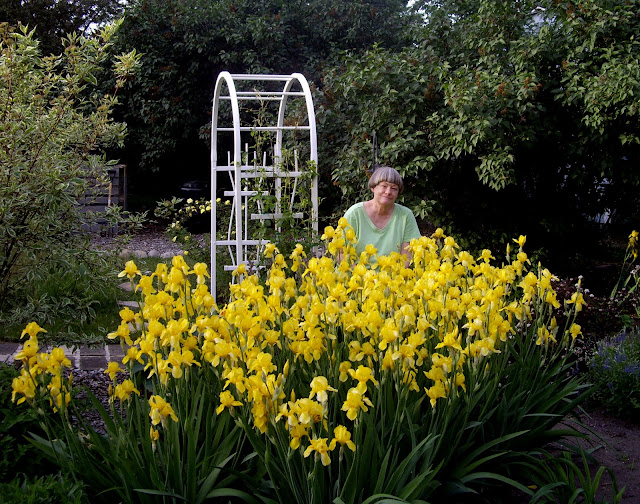Spring came early to Southern California this year, as it has in many places in the country. Although it may seem hard to believe, these photos of the tall bearded reblooming iris 'Recurring Dream' (Hager, 1992) were taken on March 13.

The next iris to join the party was 'Lady Friend.' It was moved to this spot last year because I expected it to bloom next to the red Japanese Blood Grass and the pinkish-red gazanias nearby. They may catch up to her, but they had better hurry.

I did not expect 'Recurring Dream' to bloom at the same time as 'Lady Friend,' and I have not adjusted to this color combination. Perhaps it will grow on me.

This is another unexpected bloom. A neighbor grows '
Superstition,' an almost-black iris, and I thought it would look fabulous next to my new pale yellow Austin rose '
Symphony' with almost-black violas. I went over after it was done blooming and dug up a few rhizomes- of the wrong iris. A nice, tall NOID (no identification) now blooms in 'Superstition's' spot.

Here is a photograph of all three of my earliest bloomers. I eliminated all purple from my garden two years ago. Purple is invasive.

Early blooming iris varieties are a wonderful sight in the garden. Iris foliage in the early spring is a beautiful sight on its own, and stands up well to other non-blooming perennials as a statement in the garden.
I had no idea what to put around this pond, and it sat there looking sad and barren until I hit upon the brilliant idea of putting in plants with my favorite spiky foliage.
Louisiana iris '
Spanish Ballet' (a gift from my friend Judith Gasser) is in the foreground and a historic iris that has been on the property since, oh, maybe the 1940s, is planted in the clump at center. I'll be sure to post photos when they bloom, but they are there for the foliage.

From the other direction:
And from the other side of the pond.
Spuria irises purchased at the
San Fernando Valley Iris Society plant sale wait for me to finish the masonry on a new iris bed in front of the plunge pool. I planted them in coffee cans with the bottoms removed. The plastic lids underneath have holes poked into them for drainage. When I remove the plastic, the irises will slide right out without too much trauma (she says with great confidence and no experience).

Other irises are ready to bloom within a week or two. Hager's 1992 '
Total Recall,' Keppel's 2002
'Telepathy,' Holk's 1995 '
Rose Teall,' Gibson's 1994 '
Frequent Flyer,' Gaulter's 1976
'Persian Berry,' Burseen's 1992 '
Fashion Passion,' and Begley's 1988 '
Tennison Ridge' are all getting ready to roll.
'Northwest Progress' (Schreiner, 1997) is a good sport; it will be blooming at the same time as the ajuga I put in to match its colors.
In other parts of the country, standard dwarf bearded irises and species irises are the first to bloom. Which are the first in your part of the world? Do you grow any early bloomers in your garden?









































